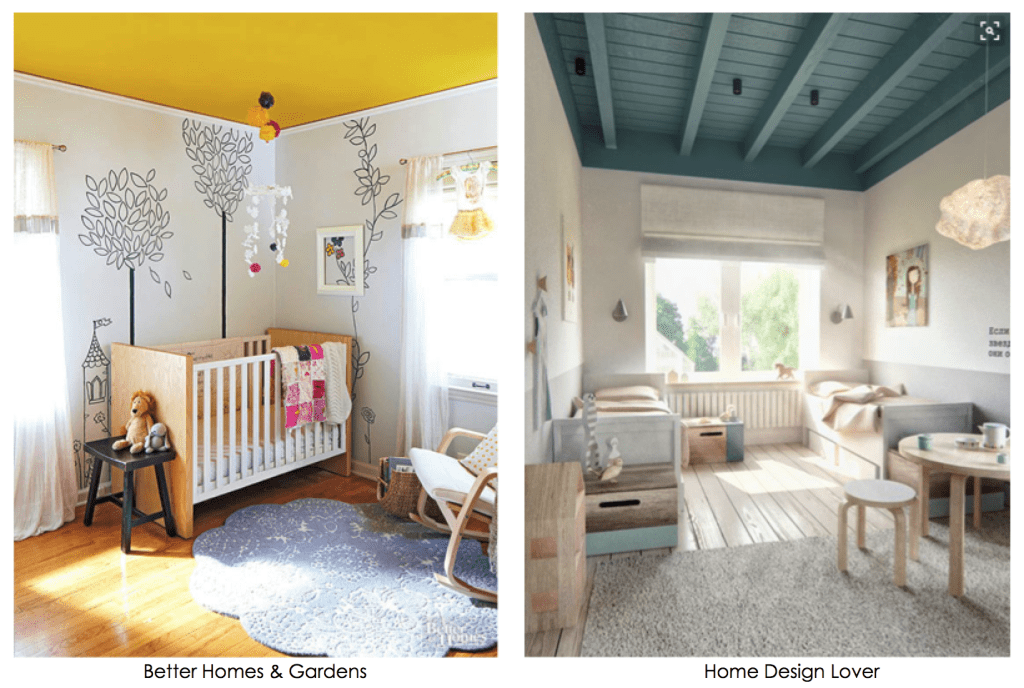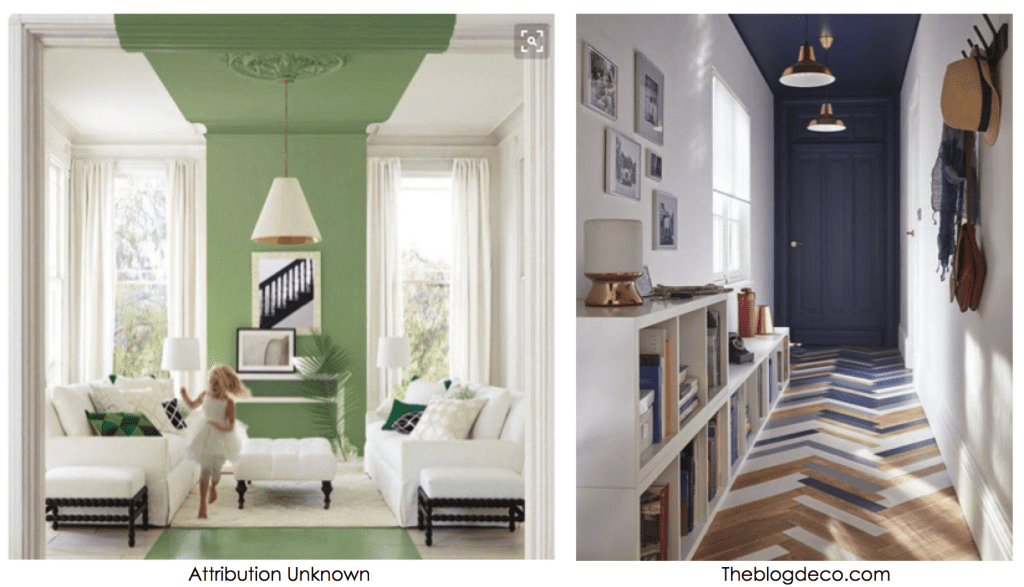
Amy Krane Color
When you’re looking to add a design detail that’s a bit out of the ordinary, consider using color on a painted ceiling. It adds an element of fun and whimsy to a room. But designers really differ on the when and how-to.
Parameters when deciding to paint a ceiling with color.
If the ceilings are low, don’t do it. When the ceiling is painted differently than the rest of the room the eye will gravitate towards it. If the ceilings are low it will accentuate this problem. If the room is very colorful already either from wall color, decor or both, don’t do it. It might tip the balance in the room and create a chaotic space. Consider the color of the walls and floor. The most sure fire way to guarantee a colored ceiling will work is by mixing it with white or off while walls.
 Next choice is with neutral, low saturation colors. Again we are looking to keep the harmony in the space by not getting too busy. Low saturation colors have a lot of grey in them which will counter balance more hue on the ceiling. Another way to prevent mistakes is by choosing the same color as the walls but changing the value (or lightness) of the color on the ceiling.
Next choice is with neutral, low saturation colors. Again we are looking to keep the harmony in the space by not getting too busy. Low saturation colors have a lot of grey in them which will counter balance more hue on the ceiling. Another way to prevent mistakes is by choosing the same color as the walls but changing the value (or lightness) of the color on the ceiling.

Types of colors to use.
Choosing to carry a muted, soothing color like a desaturated blue onto the ceiling works well. Remember in general, cool colors recede, warm colors advance. Black is tricky. Sometimes it creates the illusion of infinite space and looks like a night sky. If the ceiling is high enough this is often the case. In these circumstances it’s a wonderful choice. Other times the dark color will really make the ceiling feel like it’s coming down on you causing a cave-like ambience. A color painted on the ceiling in the wrong environment can do that.
 Note above, in the room on the left, the black is just on the ceiling but in the middle photo the black was pulled down to cover the top portion of the wall. This will, in effect, lower the ceiling so it should only be done in a room with very high ceilings. In the room on the right the black ceiling echoes the black floor, creating a very different effect than in the first two rooms whose floors are white. This creates a sort of book ended feeling ~ very cozy.
Note above, in the room on the left, the black is just on the ceiling but in the middle photo the black was pulled down to cover the top portion of the wall. This will, in effect, lower the ceiling so it should only be done in a room with very high ceilings. In the room on the right the black ceiling echoes the black floor, creating a very different effect than in the first two rooms whose floors are white. This creates a sort of book ended feeling ~ very cozy.

Choosing a warm color for your ceiling really changes the temperature of the room. Again, this is most successful in an otherwise neutral environment.
In general, I advise to use flat or matte paint on a ceiling to avoid reflections bouncing all over the room but if gloss is desired make sure the rest of the room is devoid of shine.
 Creating patterns with color can be really interesting but if you plan to pull the ceiling color onto the walls be careful how you to do it. By pulling the green onto the wall and the floor, the room on the left has created a balanced environment. I would have not painted the molding green on the entranceway as they did though. The room on the right is less successful. They’ve tried to balance the activity on the ceiling with pattern on the floor but the room feels disjointed. A doorway serves an important function and making it disappear, though playful, doesn’t help it fulfill its role to signal a place of egress.
Creating patterns with color can be really interesting but if you plan to pull the ceiling color onto the walls be careful how you to do it. By pulling the green onto the wall and the floor, the room on the left has created a balanced environment. I would have not painted the molding green on the entranceway as they did though. The room on the right is less successful. They’ve tried to balance the activity on the ceiling with pattern on the floor but the room feels disjointed. A doorway serves an important function and making it disappear, though playful, doesn’t help it fulfill its role to signal a place of egress.
 Lastly, tying the color of the ceiling into another part of the structure adds to the cohesion of the space. The black ceiling works beautifully with the black doors and trim in the loggia on the right. The bathroom on the left would have worked better without turquoise on the vanity as it’s not a part of the architecture and ends up appearing piecemeal and arbitrary.
Lastly, tying the color of the ceiling into another part of the structure adds to the cohesion of the space. The black ceiling works beautifully with the black doors and trim in the loggia on the right. The bathroom on the left would have worked better without turquoise on the vanity as it’s not a part of the architecture and ends up appearing piecemeal and arbitrary.

